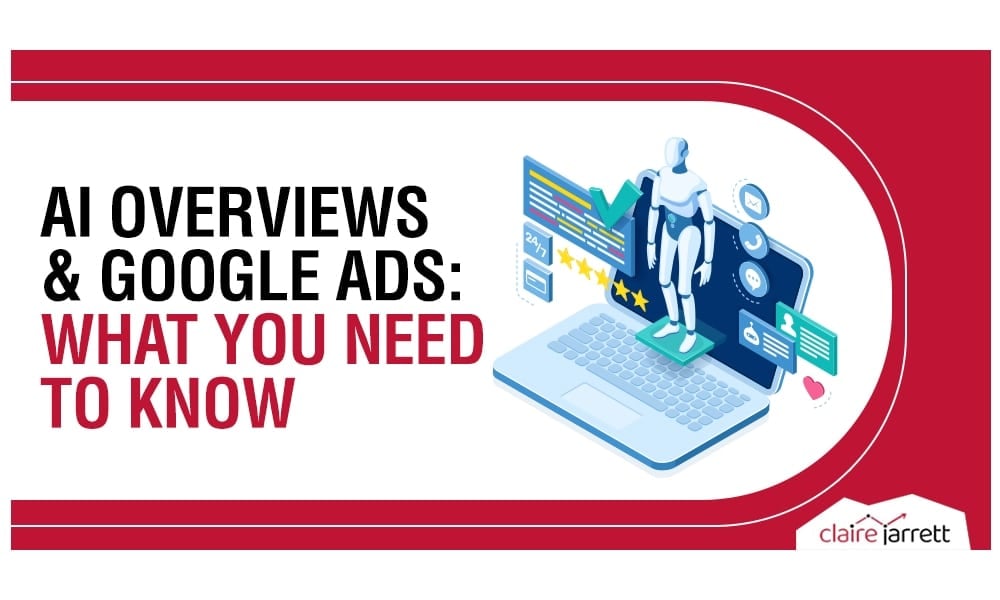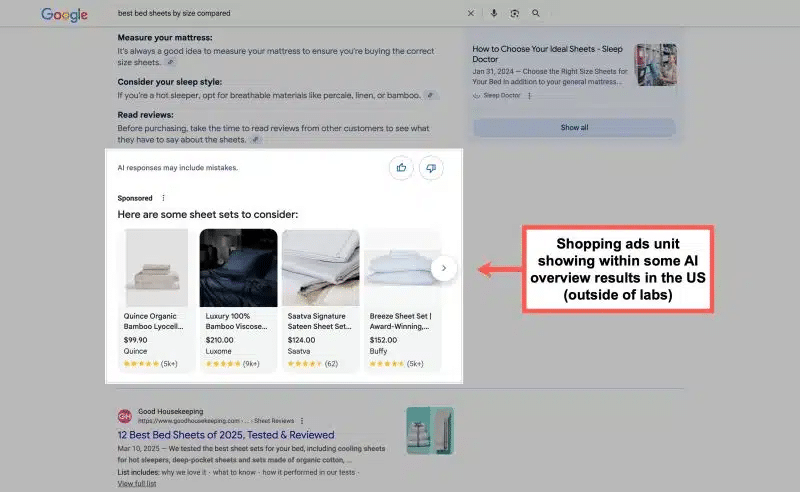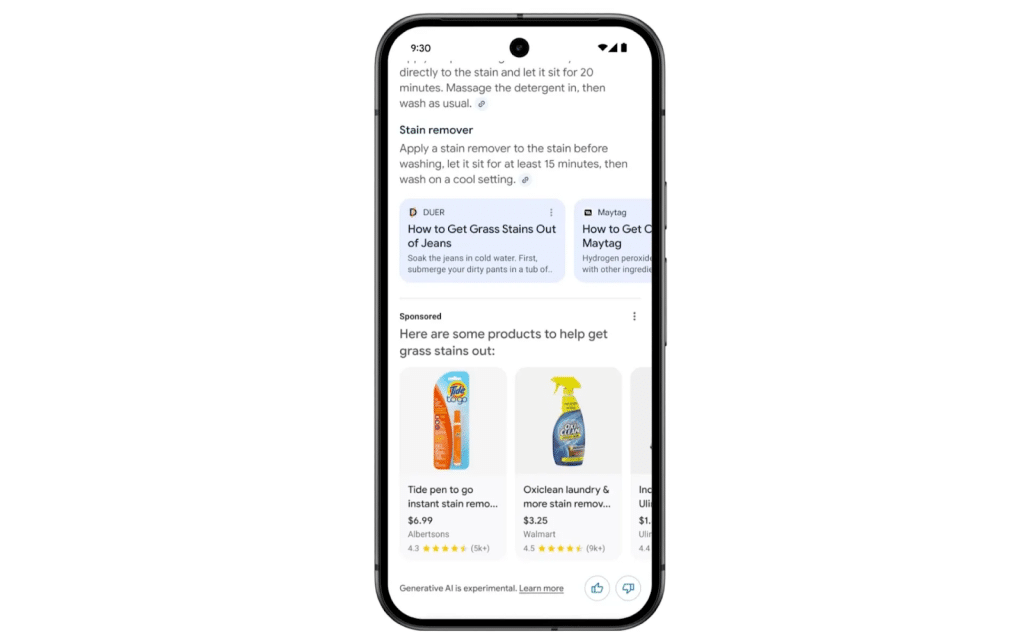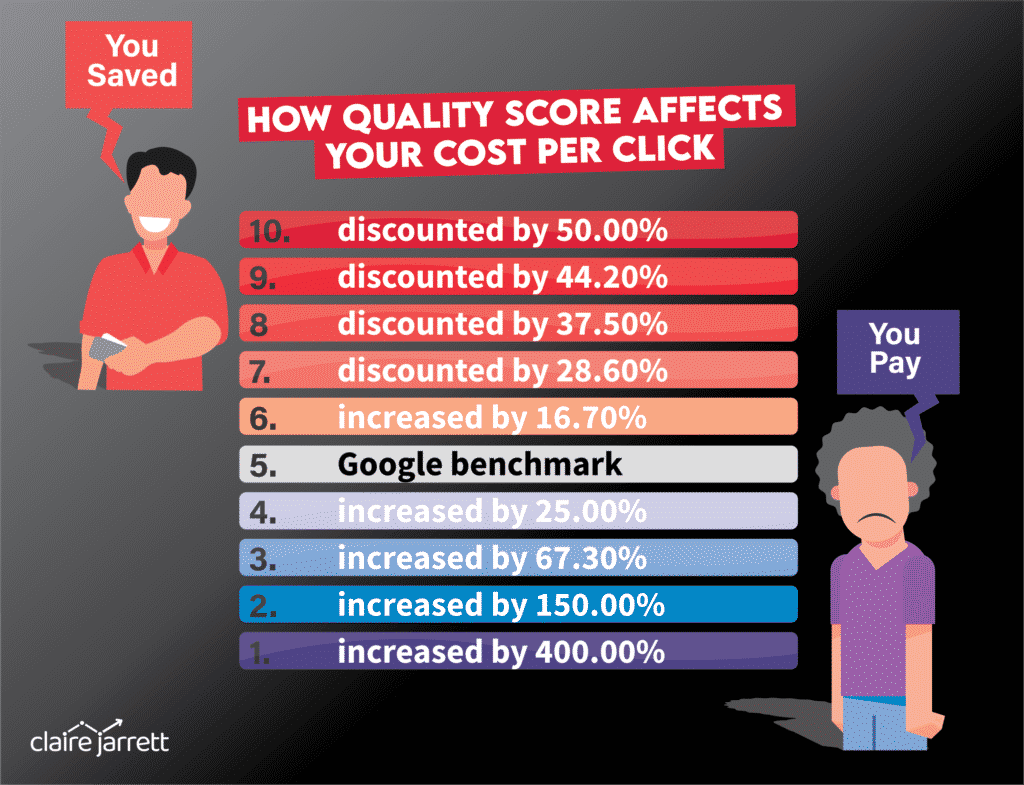Guide to AI Overviews & Google Ads

Last Updated on: 29th September 2025, 07:39 pm
Paid ads now appear inside Google’s AI-generated summaries: AI Overviews, and this is the biggest shift in ads display since Google first monetised clicks in the early 2000s.
If you run ads, you need to understand what’s happening because your ads may already be showing there, and it’s no longer “business as usual.”
Today, I’ll walk you through:
- How Google Ads in AI Overviews work
- All ad formats available
- Their benefits & what to watch out for
Let’s jump in!
What Are Google Ads in AI Overviews?
AI Overviews are Google’s layer of generative AI that sits at the top of some search results. Instead of ten blue links, searchers get a synthesised answer, complete with sources.
Now you also have ads in that block, both on mobile and desktop.
This comes in response to the rise of “zero-click searches” since Google rolled out AI Overviews. Searchers were increasingly getting their answers from the Overview itself, jeopardising the profitability of advertising within other search results.
Finally, Google confirmed the rollout of ads inside AI Overviews at Google Marketing Live in May 2025.
This followed earlier tests, but May marked the official desktop debut in the U.S., with expansion to mobile and international markets promised later in the year.
At the same time, they announced tests for ads in AI Mode, Google’s conversational AI search experience (like ChatGPT but in Google Search). That means ads could appear not only in static AI Overviews but also as part of interactive, follow-up-heavy search sessions.
Where Are AI Overview Ads Displayed?
There are now three possible placements tied to AI Overviews: above, below, and within the AI overview itself.
| Ads above & below the AI Overview | Ads inside the AI Overview | |
| Getting the placement | Same ranking system as Search Ads | More consideration of the user’s search and intent |
| Ad formats | Text, Shopping, Local, App, Performance Max | Text, Shopping, AI Max, and Performance Max ads. |
Ads inside the AI Overview are where things get interesting: it changes the psychology of how users perceive ads.
If your ad sits inside the AI’s “answer,” you’re positioned as part of the recommended solution.
For now, ads within AI overviews are live only in English, for the U.S., on desktop and mobile. Google has promised expansion to select English-speaking countries later this year. However, ads above and below AI Overviews are available wherever AI Overviews themselves are available.
Ad Formats for AI Overviews
Google has confirmed the following ad formats for AI Overview (so far):
- Search Ads (text-based, shopping, and app): Standard search ads you already run, if they win the auction and align with the AI Overview context.
- Shopping Ads: Product listings with images, pricing, and attributes.
- Performance Max inventory: Automatically pulled into AI Overview slots if the ads match both the query and the AI content.
Sensitive categories – such as finance, healthcare, politics, alcohol, gambling – are excluded for now. That’s what Google does: it rolls features out cautiously in “safe” verticals, then expands once they’ve set up the foundations.
How Do I Make My Ads Appear in AI Overviews?
There’s nothing particular you have to do to make your ads appear if they fit the categories above. When they match the query and the generated response, they should appear.
However, there are some interesting correlations I’ve noticed:
Using broad match is a must for AI Overview ads
One of the few things that Google confirmed was that your campaigns need to use broad match to appear in AI Overviews.
In part, this makes sense: users employ AI differently than they do standard searches. Their queries will be more detailed. If they’re relevant to your target keywords, your ad could appear – provided you’ve enabled broad match.
Again, this is a thing I’d like you to keep an eye on. However, it is the prime consideration in making your ads appear in AI Overviews.

Performance Max and AI Max
When Performance Max was first introduced, we were all curious to see where the “black box” of Google’s algorithm would take our ads.
I advised caution then – and I still do now.
However, there is a clear pattern: Google needs more free rein over keywords in order to use its AI to the full extent.
Test – but keep it controlled.
Bidding for Google Ads in AI Overviews
While there is not a specific bidding strategy Google wants you to use for your ads to appear, it’s much easier to auto-adjust your bids for presumably higher Overview bids if you use Smart Bidding methods.
Of course, know your acquisition costs!
Optimise the aspects in your control
Running Shopping ads? Make sure your product feeds are well-connected to your Google Ads, so the information is always fresh and accurate.
Similarly, make sure your Quality Score is as high as possible. Focus on your ideal audience segment, and have both your ads and landing page copy speak to them specifically.
The Benefits of AI Overviews
Here’s what running Google Ads in the era of AI Overviews means for your regular campaigns:
1. Going from “thinking” to “doing” faster
Someone types a meandering query, and instead of clicking five different organic results, they see your ad right in the AI’s summary.
For example, a user searching “how long do veneers last and what’s the process” might see an AI Overview that explains durability and procedure steps, with your ad offering “Book your veneer consultation today.”
Suddenly, you’re the shortcut from curiosity to action, and there is an implicit sense of Google’s result suggesting you as the best option.
2. Being the clear next step for your ideal leads
Ads inside AI Overviews don’t sit in isolation; they’re matched to the context of the summary.
If the AI answer is walking someone through Invisalign treatment, and your ad headline reads “Invisalign Specialist – Book Evening Appointments in London,” you’ve positioned yourself as the natural progression.
The user doesn’t have to wonder where to go because you’re already leading them there.
3. Google Ads in AI Overviews help you catch intent you’d normally miss
AI Overviews respond to all sorts of exploratory queries that advertisers don’t usually target. They also claim to do it while considering the intent. Your ads would only appear if Google’s algorithm evaluates that the searcher has commercial intent.
For example, “ways to fix a small gap in front teeth.”
Traditionally, you wouldn’t build a keyword list around those.
But if the AI Overview explains whitening or composite bonding and your ad is eligible to appear, you’ve just intercepted someone as they’re turning a vague thought into a potential treatment.
This doesn’t only apply to dentistry, by the way.
Imagine you’re a SaaS company. Someone Googles “best way to track customer churn without spreadsheets.” The AI Overview gives them a few ideas, but your ad for churn-tracking software shows up inside the box.
That’s a lead you’d never have caught with an exact match keyword like “customer churn tool.”
On paper, this sounds great. However, in practice, it all depends on measurement. I still recommend keeping a watchful eye on your ads, especially to ensure they don’t appear for queries that aren’t close enough to purchase.

What to Be Careful with in AI Overviews
1. Google Ads AI Overview reporting (or lack thereof)
As of September 2025, Google hasn’t clarified whether you’ll see AI Overview placements singled out in your reporting.
Currently, it doesn’t offer that.
That means you may already be paying for these clicks, but they’re inside your regular Search/Shopping campaign metrics. However, that’s not a certainty.
If you don’t know which impressions came from traditional slots versus AI Overviews, you can’t judge effectiveness.
2. Broad match dependency
Google openly says that showing in AI Overviews requires broad match or “keywordless” targeting through Performance Max.
That’s because AI Overviews trigger on complex, long-tail queries that no one’s actively bidding on. Google needs the flexibility of broad match to wedge your ad in.
That’s fine if your negatives are tight. But broad match is unpredictable: one day you’re in front of the perfect prospect, the next you’re paying for clicks on irrelevant DIY searches.
3. Quality control
AI Overviews themselves aren’t perfect. They’ve already been caught giving questionable advice.
So what happens if your ad sits inside a flawed AI summary? Your brand becomes associated with incorrect information.
Ensure your content, once clicked, provides accurate information.
4. User trust
Search Engine Land raised the transparency issue, and it’s valid.
Ads embedded in AI summaries blur the line between organic recommendations and paid placements. We still have a long way to go in testing how users respond to ads in AI Overviews.
5. Cost dynamics
These ads are premium real estate, so expect CPCs to reflect that. Google knows eyeballs land first on AI Overviews, so don’t be surprised if bids creep upward.
The only question is whether conversion rates rise enough to justify the extra cost.
Know your acquisition costs and work with an experienced Google Ads consultant to select the right strategy.
The Future of Ads in the AI Era
For twenty years, Google Search ads worked the same way: you typed a query, saw ads at the top and bottom, and clicked if the offer matched intent.
AI Overviews change that model.
It’s a fundamental shift in how users perceive the SERP. Advertisers who embrace it early will get prime visibility. Advertisers who ignore it may find their old ad slots losing share of attention.
But (and this is key) don’t fall into the trap of assuming AI Overviews ads are a silver bullet. They’re just another placement. They don’t replace the need for:
- Proper keyword strategy
- Tight negative lists
- Conversion-focused landing pages
- Ongoing optimisation
Without those, AI Overviews will simply waste your budget.
The benefits are clear, but the gaps are indicative of a new technology: limited reporting, reliance on broad match, blurred ad labelling, and the risk of paying top dollar for unproven performance.
I’ve seen it many times since starting to manage Google Ads in 2008, with the latest example being the rollout of Performance Max.
What will help you adapt? Testing and rooting yourself in knowing what works well for your campaigns already. Once you have historical information, it’s easier to apply the strategies that already work for you in a new format.
Finally, one thing’s certain: AI Overview ads might prove powerful, but only if you’re willing to do the hard work of structuring campaigns properly.
Brush up on the foundations of Google Ads with my best-selling book, or contact me for a consultation.



